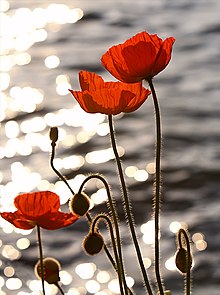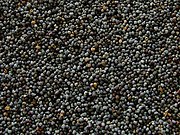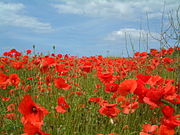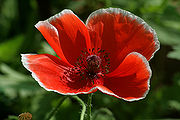Hi Everybody! Welcome and Please Come In.
I am brendasue (aka: Grandma Poppy). This Blog is an informal mini Nature Class. I own Kates Cabin Bird Sanctuary in Texas and photodocument the life around me. Tonight we are going to look in my butterfly garden at my favorite flower: The Poppy. I can grow a few California Poppies, but when the Texas Sun gets too hot, they are gone!
I collected some good information for us about the Poppy and found some interesting vids!
There are many varieties of Poppies, including the Opium Poppy. Great drugs to relieve pain come from this Poppy. Sadly, the street drug Heroin also comes from the Opium Poppy. I want to be clear that I do not/have not used the street drug and I hope people do not make the choice to use heroin. Our focus tonight will be on the beauty of the flowers rather than the chemical properties of the plant.
Your photostudy tonight is the California Poppies in my Butterfly Garden. Enjoy the flowers and the great videos!
Just Push Play>
Poppy
From Wikipedia, the free encyclopedia
Poppy flowers have 4 to 6 petals. The petals may be almost any color, and some have markings. Before blooming, the petals are crumpled in the bud, and as blooming finishes, the petals often lie flat before falling away. A whorl of stamens is in the center of the flower.
The pollen of the oriental poppy, Papaver orientale, is dark blue. The pollen of the field poppy or corn poppy (Papaver rhoeas) is dark blue to grey. Bees use poppies as a pollen source.
Poppies belong to genera of Papaveraceae, which includes:
- Papaver – corn poppy, Opium poppy, Oriental poppy, Iceland poppy, and about 120 other species
- Eschscholzia – California poppy and relatives
- Meconopsis – Welsh poppy, Nepal poppy, and relatives
- Stylophorum – Celandine poppy or wood poppy
- Argemone – Prickly poppy
- Romneya – Matilija poppy and relatives
- Canbya – Pygmy poppy
- Stylomecon – Wind poppy
- Arctomecon – Desert bearpaw poppy
- Hunnemannia – Tulip poppy
- Dendromecon – Tree poppy
Just Push Play>
Gallery
Opium poppy
From Wikipedia, the free encyclopedia
Opium poppy, Papaver somniferum, is the species of plant from which opiumand poppy seeds are derived. Opium is the source of many narcotics, includingmorphine (and its derivative heroin), thebaine, codeine, papaverine, andnoscapine. The Latin botanical name means the "sleep-bringing poppy", referring to the sedative properties of some of these opiates.
The poppy is the only species of Papaveraceae that is an agricultural crop grown on a large scale. Other species, Papaver rhoeas and Papaver argemone, are important agricultural weeds, and may be mistaken for the crop.
The plant itself is also valuable for ornamental purposes, and has been known as the "common garden poppy", referencing all the group of poppy plants.
Poppy seeds of Papaver somniferum are an important food item and the source of poppyseed oil, a healthful edible oil that has many uses. It is widely grown as an ornamental flower throughout Europe, North America, South America, and Asia
| Opium poppy | |
|---|---|
 | |
| Papaver somniferum | |
| Scientific classification | |
| Kingdom: | Plantae |
| Division: | Magnoliophyta |
| Class: | Magnoliopsida |
| Order: | Ranunculales |
| Family: | Papaveraceae |
| Genus: | Papaver |
| Species: | P. somniferum |
Varieties
Papaver somniferum has many sub-species or varieties and cultivars. Colors of the flower vary widely, as do other physical characteristics such as number and shape of petals, number of flowers and fruits, number of seeds, color of seeds, production of opium, etc.
Papaver somniferum Paeoniflorum Group (sometimes called Papaver paeoniflorum) is a sub-type of opium poppy whose flowers are highly double, and are grown in many colors. Papaver somniferum Laciniatum Group (sometimes called Papaver laciniatum) is a sub-type of opium poppy whose flowers are highly double and deeply lobed, to the point of looking like a ruffly pompon.
A few of the varieties, notably the Norman and Przemko varieties, have low morphine content (less than one percent), much higher concentrations of other alkaloids. Most varieties, however, including those most popular for ornamental use or seed production, have a higher morphine content, with the average content being 10%.[2][3]
[edit]Opiates
The opium poppy is the principal source of most naturally occurring μ-opioid receptor agonist opioids. The opium poppy is, by definition, the root source of all opioids consideredopiates. Opiates are extracted from opium and poppy straw. Opium (also called “raw opium”) is the latex harvested by making incisions on the green capsules (seed pods). Poppy straw is the dried mature plant except the seeds, harvested by mowing.
From opium and poppy straw, alkaloids are extracted such as morphine, thebaine, codeine and oripavine. Morphine is the predominant alkaloid found in the varieties of opium poppy plant cultivated in most producing countries.[4]
[edit]History
Use of the opium poppy predates written history. Images of opium poppies have been found in ancient Sumerian artifacts (ca. 4000 BC). The making and use of opium was known to the ancient Minoans.[5] Its sap was later named opion by the ancient Greeks, from where it gained its modern name of opium.
Opium was used for treating asthma, stomach illnesses, and bad eyesight. The First and Second Opium Wars between China, theBritish Empire and France took place in the late 1830s through the early 1860s when the Chinese attempted to stop western traders smuggling opium into their country.
Many modern writers, particularly in the nineteenth century, have written on the opium poppy and its effects, notably L. Frank Baum inThe Wonderful Wizard of Oz and Thomas de Quincey in Confessions of an English Opium Eater
The French Romantic composer Hector Berlioz used opium to be inspired, subsequently producing his Symphonie Fantastique. In this work, a young artist overdoses on opium and experiences a series of visions of his unrequited love.
Opium poppies (flower and fruit) appear on the coat of arms of the Royal College of Anaesthetists.
[edit]Legality
- Opium poppy cultivation in the United Kingdom does not require a license, but extracting opium for medicinal products does.[6]
- In Italy it is forbidden to grow Papaver somniferum to extract the alkaloids, but small numbers of specimens can be grown without special permits for purely ornamental purposes.[citation needed]
- In the United Arab Emirates, where the drug law is especially stern, at least one man was reported to have been imprisoned for possessing poppy seeds obtained from a bread roll.[7]
- In northern Burma opium bans have ended a century old tradition of growing poppy. Between 20,000 and 30,000 ex-poppyfarmers left the Kokang region as a result of the ban in 2002.[8] People from the Wa region, where the ban was implemented in 2005, fled to areas where growing opium is still possible.
- In the United States, opium is listed as a Schedule II controlled substance by the Drug Enforcement Administration. In addition, "Opium poppy and poppy straw" are also prohibited.[9] However, this is not typically enforced for poppies grown or sold for ornamental or food purposes.[2] Though the opium poppy is legal for culinary or æsthetic reasons, poppies were once grown as a cash crop by farmers in California, the law of poppy cultivation in the United States is somewhat ambiguous.[10] The reason for the ambiguity is because, now repealed,[11][12][13] The Opium Poppy Control Act Of 1942 stated that any opium poppy should be declared illegal, even if the farmers were issued a State permit.[14] § 3 of The Opium Poppy Control Act stated:
- It shall be unlawful for any person who is not the holder of a license authorizing him to produce the opium poppy, duly issued to him by the Secretary of the Treasury in accordance with the provisions of this Act, to produce the opium poppy, or to permit the production of the opium poppy in or upon any place owned, occupied, used, or controlled by him.
- This led of to the Poppy Rebellion, and to the Narcotics Bureau arresting anyone planting opium poppies and forcing the destruction of poppy fields of anyone who defied the prohibition of poppy cultivation.[15][16] Though the press of these days showed favourtowards the Federal Bureau of Narcotics, the state of California supported the farmers who grew opium poppies for their seeds. Today, this area of law has remained vague and remains a controversy in the United States.[17] The Opium Poppy Control Act of 1942 was repealed on 27 October of the year 1970.[18][19]
- The seeds themselves contain very small amounts of opiates.[2] However, the television show MythBusters demonstrated that one could test positive for narcotics after consuming four poppy seed bagels. On the show Brainiac: Science Abuse, subjects tested positive after eating only two poppy seed bagels.
[edit]Poppies as medicine
Australia, Turkey and India are the major producers of poppy for medicinal purposes and poppy-based drugs, such as morphine or codeine.[20] The USA has a policy of sourcing 80% of its narcotic raw materials from the traditional producers, India and Turkey.[21]
A recent initiative to extend opium production for medicinal purposes called Poppy for Medicine was launched by The Senlis Council which proposes that Afghanistan could produce medicinal opium under a scheme similar to that operating in Turkey and India.[22] The Council proposes licensing poppy production in Afghanistan, within an integrated control system supported by the Afghan government and its international allies, to promote economic growth in the country, create vital drugs and combat poverty and the diversion of illegal opium to drug traffickers and terrorist elements. Interestingly, Senlis is on record advocating reintroduction of poppy into areas of Afghanistan, specifically Kunduz, which has been poppy free for some time.
The Senlis proposal is based in part on the assertion that there is an acute global shortage of opium poppy-based medicines some of which (morphine) are on the World Health Organisation's list ofessential drugs as they are the most effective way of relieving severe pain. This assertion is contradicted by the International Narcotics Control Board (INCB), the "independent and quasi-judicial control organ monitoring the implementation of the United Nations drug control conventions". INCB reports that the supply of opiates is greatly in excess of demand.[23]
The British government has given the go-ahead to the pharmaceutical company Macfarlan Smith (a Johnson Matthey company) to cultivate opium poppies in England for medicinal reasons. This move is well-received by British farmers, with a major opium poppy field based in Didcot, England.[24]
In March 2010, researchers from the Department of Biological Sciences at the University of Calgary published an article in Nature Chemical Biology about their discovery of two enzymes and their encoding genes, thebaine 6-O-demethylase (T6ODM) and codeine O-demethylase (CODM), involved in morphine biosynthesis derived from the opium poppy.[25] The enzymes were identified as non-hemedioxygenases, and were isolated using functional genomics.[25] Codeine O-demethylase produces the enzyme that converts codeine into morphine.[26]
[edit]Use as food
The opium poppy is the source of two food ingredients: poppy seed and poppyseed oil. The seeds contain very low levels of opiates,[2] and the oil extracted from them contains even less. Both the oil and the seed residue also have commercial uses.
[edit]Poppy seeds
Main article: Poppy seed
Poppy seeds are commonly used in cuisine from many different cultures. Poppy seeds can be dry roasted and ground to be used in wet curry (curry paste) or dry curry. They have a creamy and nut like flavor, and when used with ground coconut, the seeds provide a unique and flavour-rich curry base.[27]
[edit]Ornamental cultivation
Once known as the "common garden poppy", live plants and seeds of the opium poppy are widely sold by seed companies and nurseries in most of the western world, including the United States. Poppies are sought after by gardeners for the vivid coloration of the blooms, the hardiness and reliability of the poppy plants, the exotic chocolate-vegetal fragrance note of some cultivars, and the ease of growing the plants from purchased flats of seedlings or by direct sowing of the seed. Poppy seed pods are also sold for dried flower arrangements.
It has been suggested that, since "opium poppy and poppy straw" are listed in Schedule II of the United States' Controlled Substances Act, a DEA license may be required to grow poppies in ornamental or display gardens. In fact the legal status of strictly ornamental poppy gardens is more nuanced, and destruction of ornamental poppy installations or prosecution of gardeners (except those caught extracting opium via capsule scarification or tea extraction) are virtually unheard of.[2] During the early spring, opium poppies can be seen flowering in gardens throughout North America and Europe, and beautiful displays are found in many private planters, as well as in public botanical and museum gardens (e.g. United States Botanical Garden, Missouri Botanical Garden, North Carolina Botanical Garden, residential garden, Seattle, WA, and residential garden, Hartford, CT).
Many countries grow the plants, and some rely heavily on the commercial production of the drug as a major source of income. As an additional source of profit, the seeds of the same plants are sold for use in foods, so that cultivation of the plant is a significant source of income. This international trade in seeds of Papaver somniferum was addressed by a UN resolution "to fight the international trade in illicit opium poppy seeds" on 28 July 1998.
Just Push Play>
http://www.va.gov/opa/publications/celebrate/flower.pdf
The Flower of Remembrance
In Flanders Fields
By John McCrae
In Flanders fields the poppies blow
Between the crosses, row on row,
That mark our place; and in the sky
The larks, still bravely singing, fly.
Scarce heard amid the guns below.
We are the dead. Short days ago
We lived, felt dawn, saw sunset glow
Loved, and were loved, and now we lie
In Flanders fields.
Take up our quarrel with the foe:
To you from failing hands we throw
The torch; be yours to hold it high.
If ye break faith with us who die
We shall not sleep, though poppies grow
In Flanders fields.
Just Push Play>
The following images are from my garden! Enjoy!
This concludes our photostudy of the Poppy.
Goodnight Everybody!
....this is brendasue signing off from Rainbow Creek.
See You next time.
Of course, One more great performance!
Just Push Play> This is so Great! I love it! Sweet Dreams!
O+O




















-001.jpg)
.JPG)
.JPG)
.JPG)
.JPG)
.JPG)
.JPG)
.JPG)
.JPG)
.JPG)
.JPG)
.JPG)
.JPG)
.JPG)
.JPG)

.JPG)


.JPG)
.JPG)
.JPG)
.JPG)
.JPG)
.JPG)
.JPG)
No comments:
Post a Comment
Hi Everybody! Please say hello and follow so I know you are here! Due to the inconsideration of people trying to put commercials on my blog comment area, I have restricted use of anonymous posts. Sorry that some hurt all.
My public email is katescabin@gmail.com No spammers or trolls